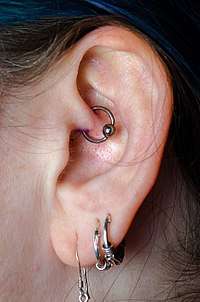Daith piercing
| Daith piercing | |
|---|---|
 | |
| Location | Ear cartilage |
| Jewelry | Captive bead ring |
| Healing | 3-6 months[1] |
A Daith piercing, pronounced /ˈdeɪθ/ (rhymes with 'faith') or /ˈdʌθ/ (homophonous with 'doth'), is an ear piercing that passes through the ear's innermost cartilage fold, the crus of the helix.[2]
The piercing is located in an awkward, curvy place and is usually pierced with a straight hollow needle. Captive bead rings are the most common jewellery type used.
History
A client of Erik Dakota, who is said to have been studying Hebrew in college, first named this piercing "da'at" (meaning "knowledge"). Her reasoning was that the piercer must have been very "smart" to figure out how to do the piercing. This piercing was first brought into the public eye in Fakir Musafar's Body Play Magazine, in the same issue that also showcased the Industrial Piercing, the Apadydoe, and a large dermal punch in the outer conch.
Fakir Musafar added, "The Daith piercing was co-created in 1992 by Erik Dakota and a Jewish woman piercing client with a metaphysical bent. ... A true Daith must be done in such a way that the bottom part of the ring appears to come directly out of the ear canal. If one can see both the entrance and exit hole of the ring, it is not a true Daith. The technique for this piercing is quite advanced, requires a specifically curved needle and was devised by Erik Dakota. This technique is taught at Advanced Fakir Piercing Intensive."[3]
Migraine relief
According to the Cleveland Clinic, daith piercing has been claimed to be a "highly unconventional remedy" for migraines. The clinic states that there is "no medical research that supports this theory" and that the only relief people are experiencing is due to a "temporary placebo effect". The clinic quotes Emad Estemalik, MD, "There’s nothing in literature I’ve heard of, nothing I’ve read about, nothing I have studied out there that supports such a procedure to treat migraine".[4]
References
- ↑ Hudson, Karen L. "Daith Piercings - All About Daith Piercings". About Style. About.com. Retrieved 17 December 2014.
- ↑ "Daith". BME Encyclopedia. BMEZine. Retrieved 5 October 2017.
- ↑ BODY PLAY #4, 1992, "The Unique Piercings of Erik Dakota"
- ↑ "Can An Unconventional Piercing Rid You of Migraine Pain? The scientific evidence is lacking to support the claim of a cure". Health Essentials. Cleveland Clinic. Retrieved 2 June 2017.